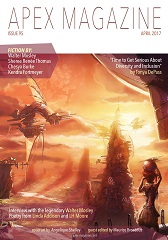“Cut, Cut, Cut” by Walter Mosley
“Aunt Dissy’s Policy Dream Book” by Sheree Renée Thomas
“Say, She Toy” by Chesya Burke
“The Selkie Wives” by Kendra Fortmeyer
Reviewed by Stephanie Wexler
Marilee Frith-DeGeorgio in “Cut, Cut, Cut” by Walter Mosley gets by creating social media advertising to pay rent, producing bad pottery and spending her days pursuing men on a date site called People for People. Pretty sure her ideal man is not her husband or her first date (body odor challenged) and then she meets Martin, man of mystery and plastic surgeon. It isn’t long before Marilee discovers Martin is too good to be true, when she is interviewed by a Detective Wade. The Detective claims he is still a subject of interest in their missing persons case. What is even stranger is Martin’s version sketches a love affair. Despite Martin’s omission, she continues to act as double agent for Detective Wade. The mystery deepens and her tryst with Martin becomes more than just a nightly romp between the sheets. She even confesses to her sister this double agent role is arousing her even more. Martin is pretty accepting of her questions and isn’t even upset that she is probing. At this point, I am committed to seeing where Marilee’s actions lead her and why Martin is so adamant that Marilee visit his lab. Marilee’s VIP status gains her access and the big reveal is a bit anti-climatic. Almost like a Doctor Evil’s offshoot plan in an Austin Powers movie, but you will have to decide if what Martin is doing verges on criminal or an evolutionary step up.
Cassie is a psychic in “Aunt Dissy’s Policy Dream Book” by Sheree Renée Thomas. Raised by her Aunt Dissy after her mother died, Cassie’s ability to connect with people through dreams has become a torture. The sight overtakes her literally like a force of nature. Each dream vision somehow ends up scarring her physically. Correctly foretold by Aunt Dissy, Cassie is riddled with dreams that incorporate people from the past, present and future. Time doesn’t refine her ability either. The dreams start invading her waking moments. The lack of guidance, sleepless nights, and physical consequences start wearing her down. Before Aunt Dissy passed away, what little instruction she provided proved inadequate. Other than a spiritual codex, handed down as a guide book and read cover to cover provides little aid, so full of codes and inconsistent information. Cassie is forced to bumble her way through her gift. Despite her disdain and outright rejection of her abilities she needs to pay the rent. Even when riddled with guilt by a misinterpreted reading and insomnia from trying to reject her gift, she has no choice but to forge on. It is when Cassie has reached her limit that the boundary between client reading and Cassie’s interaction blurs and what she really needs reveals itself. There are so many elements to Cassie’s character intertwined with her gifts; the people she meets and helps, and her own journey for balance and self forgiveness turns this story into a wild ride.
Cloe, a prototype android, initially developed as a psychiatric tool to reduce human on human abuses, sounds like a noble idea. We follow Cloe as “she” is hired by different clients with broadly unique, domestic, and/or shockingly violent, sexually charged behavior. Each encounter shapes and molds her abilities to relate to humans. Even her inventor, Jacob, continually pushes her programming, providing reference material and spending time analyzing her jobs. Then Cloe meets Sheryl. Sheryl is on a mission to free androids from their abusive fate. I assume Sheryl is a client, but the meeting is so out of place I wonder how Sheryl managed to get the time slot. Neither is the meeting discussed by Jacob ,so we only have Cloe and Sheryl’s conversation to draw conclusions. Cloe is puzzled by the Sheryl interview and as per her programming reacts to Sheryl’s concern for her welfare in a drastically different way. Out of all of Cloe’s interactions you wonder if androids can achieve a sense of self? After reading the last two lines of this story “Say, She Toy” by Chesya Burke you wonder if Cloe is a victim or a tragic heroine. Is Sheryl right? All I can say is, it is another fascinating chapter of A.I. evolution started by Philip K. Dick’s story “Can Androids Dream of Electric Sheep.”
“The Selkie Wives” by Kendra Fortmeyer reweaves the Irish/Scottish mythological creature tale of the Selkies with some modern embellishments. At first, I wondered where our author was leading us since the narrative followed the myth pretty faithfully. I need not have doubted the cunning structure of the story. Kendra’s unique spin to each version gains momentum and becomes more hilarious with each telling. Just to give you a taste of the quirky nature of one adaptation, we tag along with a Selkie who is tired of lying around tide pools. She starts her own blog, makes appearances on talk shows discussing family values, and shocks the hosts about abductions. Her many fans stand in line to meet her and buy posters and faux seal skin shoes as she tours the world. Not bad for a Selkie! Even though the author takes creative liberties with an age old tale she keeps the basic concept of the Selkies behavior intact, showing how their underlying nature and urges grant them great adventures.
 Apex #95, April 2017
Apex #95, April 2017